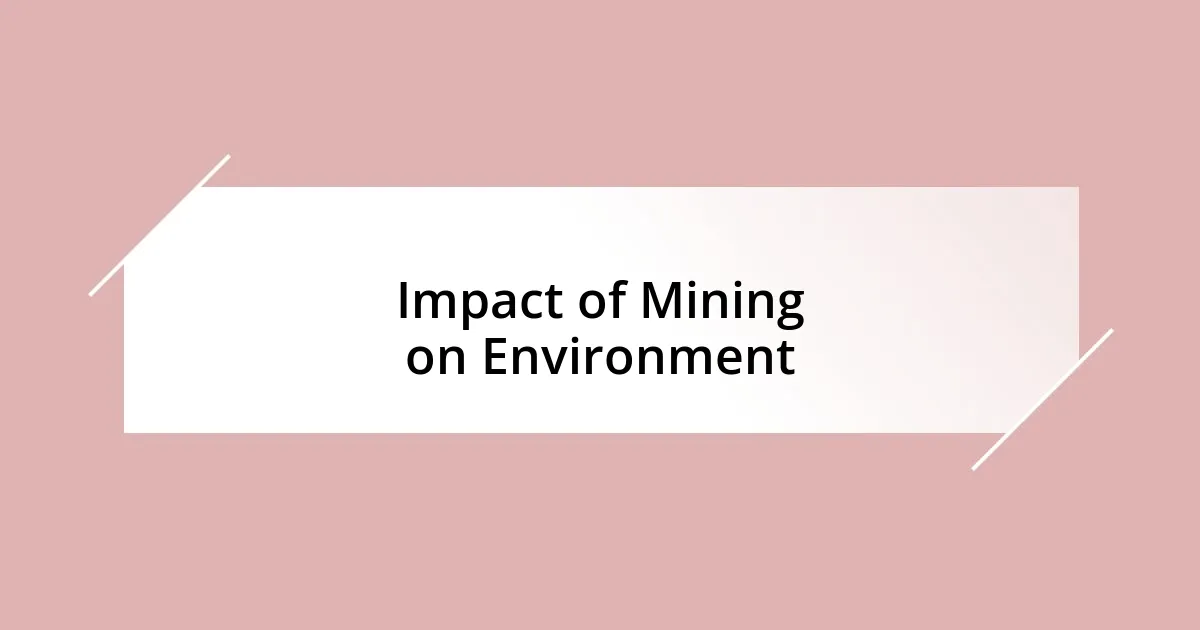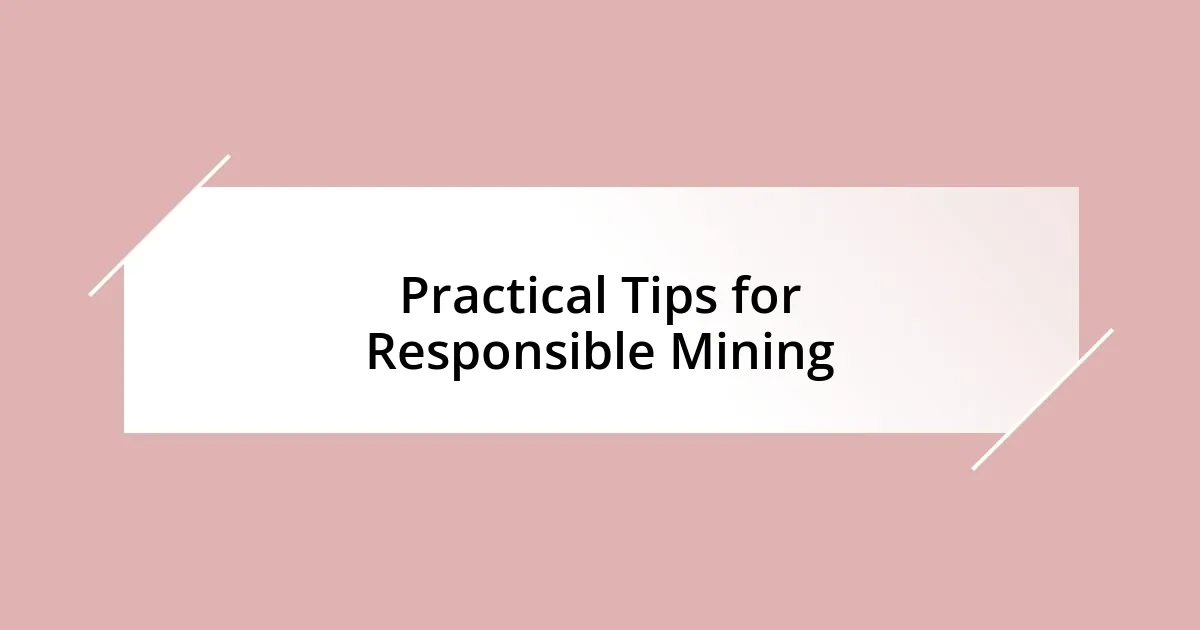Key takeaways:
- Eco-conscious mining groups prioritize sustainable practices, viewing environmental preservation and community engagement as essential components of their operations.
- Mining significantly impacts the environment, causing deforestation, water pollution, and contributing to climate change, highlighting the need for a shift towards responsible practices.
- Successful case studies demonstrate the effectiveness of innovative techniques, such as using native plants for land reclamation and advanced technologies like drones and AI for monitoring environmental impacts.
- Future trends in eco-conscious mining include increasing reliance on renewable energy, adopting circular economy principles, and leveraging technology to enhance sustainability and operational efficiency.

Understanding Eco-Conscious Mining Groups
Eco-conscious mining groups are fundamentally different. They prioritize sustainable practices, balancing resource extraction with environmental preservation. When I first learned about their approach, I found it striking how they treat the earth as a partner rather than a resource to exploit. Isn’t it refreshing to think of mining not just as a means to an end, but as a relationship?
These groups often employ innovative techniques that minimize land degradation and pollution. For instance, they use advanced technology to reduce waste and manage water resources effectively. I remember visiting a site where they showcased their efforts in reclamation—transforming abandoned mining areas back into thriving ecosystems. It was heartwarming to see the actual impact these initiatives could have on local wildlife and communities.
What truly fascinates me is the collaborative spirit within eco-conscious mining. They often work closely with local communities to address concerns and incorporate traditional knowledge into their practices. Have you ever thought about how community involvement can lead to better outcomes? From my experience, these partnerships not only strengthen local ties but also foster trust and transparency, making everyone invested in the success of eco-friendly initiatives.

Impact of Mining on Environment
Mining has a profound impact on the environment, often leading to irreversible damage. My first encounter with this reality happened during a trip to a mining region where I witnessed firsthand the deforestation and habitat destruction caused by mining activities. It was shocking to see how entire landscapes could be altered so quickly, leaving behind scars on the earth that could take decades, if not centuries, to recover. The deforestation not only affects the flora but also displaces countless animals, disrupting ecosystems that have existed for millennia.
Then there’s the issue of water pollution. In one case, I visited a community that sourced its drinking water from a river running adjacent to an unregulated mining operation. The locals shared stories about how contaminated water directly impacted their health and livelihoods. Experiencing their struggles made it painfully clear: the repercussions of mining extend far beyond the extraction of minerals. They ripple through communities, affecting everything from public health to economic stability.
Lastly, the climate impact is significant and often overlooked. The emissions from mining operations contribute to global warming. I remember being part of a discussion where environmental scientists emphasized the carbon footprint associated with different mining methodologies. It drove home the urgency of adopting sustainable practices. How can we move forward if we continue to let mining operations expand without considering the environmental cost? In my opinion, we need a paradigm shift towards eco-conscious mining that embraces responsibility and innovation.
| Environmental Impact | Description |
|---|---|
| Deforestation | Mining often leads to significant loss of trees and biodiversity, disrupting ecosystems. |
| Water Pollution | Contaminants from mining activities can poison rivers, affecting local communities and wildlife. |
| Climate Change | Mining operations generate greenhouse gas emissions, contributing to global warming. |

Principles of Sustainable Mining Practices
The principles of sustainable mining practices center around a commitment to both environmental stewardship and community engagement. I had a lightbulb moment when I discovered that sustainable mining isn’t just about adhering to regulations—it’s about being proactive in creating a positive impact. It requires a mindset shift where every action is taken with the end goal of preserving the earth and its resources.
Here are some core principles that guide these practices:
- Resource Efficiency: Utilizing technology to maximize resource extraction while minimizing waste.
- Biodiversity Conservation: Integrating efforts to protect local flora and fauna during mining operations.
- Water Management: Implementing systems to recycle and properly treat water, reducing pollution.
- Community Engagement: Actively involving local communities in decision-making processes and respecting their traditional knowledge.
- Rehabilitation and Reclamation: Making commitments to restore ecosystems post-mining, ensuring a fruitful recovery for the land.
In my experiences with sustainable mining initiatives, I have seen how these principles can transform the industry. I vividly recall a workshop led by a mining company that turned its reclamation plans into a community project. Watching local kids plant trees in a once-barren area felt like nurturing hope. It was more than just an environmental effort; it fostered a sense of ownership and pride among locals. This collaborative environment reminded me of how holistic policies can change lives while changing landscapes for the better.

Benefits of Joining Eco-Conscious Groups
Joining eco-conscious mining groups offers numerous benefits that resonate deeply with anyone invested in sustainable practices. One of the most significant advantages I’ve experienced is the sense of community that comes from connecting with like-minded individuals. Sharing stories and strategies with others who are equally passionate about reducing environmental harm makes the journey feel less daunting. It’s empowering to engage with people who inspire you, and honestly, it transforms the narrative from a struggle into a collective mission. Have you ever felt that surge of motivation after a meaningful conversation? I know I have.
Another notable benefit is accessing valuable resources and knowledge. During one of my group meetings, a participant shared an innovative technique for reducing water pollution in mining. I was amazed at how something as simple as using natural filtration could make a substantial difference. Learning from real-life applications in the field highlights the practicality of sustainable methods, and that level of insight can dramatically influence how I approach my own projects. It’s a reminder that staying informed and adaptable is crucial, especially when the stakes are so high. How often do we come across such treasure troves of wisdom?
Lastly, being a part of eco-conscious groups enhances personal and professional growth. The discussions and workshops often push me to think critically and challenge conventional practices. During a particularly engaging session, one of our leaders encouraged us to envision the future of mining without destructive practices. It felt liberating to imagine the possibilities. In my view, these experiences broaden horizons, allowing for innovative thinking that can lead to more sustainable outcomes—both for our planet and our communities. Isn’t it exhilarating to know that our choices can lead to impactful change?

Successful Case Studies in Eco-Mining
One standout case study that comes to my mind involves a mining cooperative in the Andes, which turned traditional practices upside down. They implemented a system to reclaim the land by using native plants, creating not only a lush landscape but also a thriving habitat for wildlife. When I visited, seeing the vibrant colors and hearing the sounds of nature felt like a rebirth, a clear demonstration that eco-conscious practices can lead to a flourishing ecosystem. How often do we see tangible proof of our efforts paying off like that?
Another impressive example I’ve encountered is the use of advanced drone technology to monitor mining sites. A company in Africa adopted this innovative approach, allowing them to oversee environmental impact with pinpoint accuracy. I remember the excitement in the room during the presentation when they revealed the data analysis that highlighted areas needing immediate attention. It hammered home the point that technology can be a fierce ally in sustainable mining practices. Isn’t it inspiring how the right tools can empower us to protect the planet more effectively?
Lastly, the collaboration between a local mining firm and environmental NGOs in Canada pushed the envelope on community involvement. They created a forum where miners and locals could openly share concerns and insights. It was genuinely heartening to witness the relationship evolve, reminding me of the value in truly listening to each other. This experience solidified my belief that partnerships built on trust pave the way for solutions that benefit both the community and the industry. Isn’t that what we all strive for?

Practical Tips for Responsible Mining
When it comes to responsible mining practices, one of the simplest yet most effective tips is to prioritize local engagement. I remember the first time I attended a community meeting held by a mining company. Seeing the miners actively listening to residents’ concerns firsthand illustrated the power of open dialogue. Have you ever been a part of a conversation that turned a tense situation into a collaborative effort? It felt like a weight lifted as mutual understanding grew, highlighting how essential it is to involve the community in decision-making processes.
Another practical tip is to invest in innovative technology that minimizes environmental impact. Recently, I came across a startup utilizing 3D mapping to monitor land use changes in mining zones. The excitement was palpable when the leaders explained how this technology could predict potential ecological disruptions before they happen. Can you imagine the difference we could make if all industries adopted similar technologies? This kind of proactive approach not only protects the environment but also improves operational efficiency.
Lastly, developing a comprehensive waste management plan is crucial. I learned this the hard way during a project where inadequate waste disposal led to contamination in nearby water sources. It was a reminder of how negligence can quickly spiral into larger issues. So, what can we do to prevent such mistakes? By committing to recycling and safe disposal protocols, we can drastically reduce our environmental footprint. It’s about taking responsibility—how can we expect to create positive change if we ignore the basics?

Future Trends in Eco-Conscious Mining
As I look ahead to the future of eco-conscious mining, one trend that really catches my attention is the increasing reliance on renewable energy sources. I remember visiting a solar-powered mining operation, where the blend of sunlight and minerals was nothing short of magical. It struck me how investing in solar panels not only cut emissions but also lowered operational costs. Isn’t it amazing how harnessing nature’s energy can transform an industry?
Another exciting trend is the rise of circular economy principles in mining. I once spoke with a mining engineer who shared how they repurpose waste materials for new projects. Their commitment not only reduced landfill impact but also opened new revenue streams. This approach prompts a thought: what if every industry adopted a similar mindset? The potential for reducing waste and maximizing resources is endless!
Finally, technology like artificial intelligence (AI) is reshaping how we address environmental challenges in mining. I vividly recall a workshop where experts showed us how AI could analyze real-time data to identify pollution spikes before they escalate. The room buzzed with energy as we realized the implications for proactive environmental management. It makes me ponder, how can we leverage such cutting-edge technologies to safeguard our planet while still meeting the demand for minerals? The future indeed holds exciting possibilities for eco-conscious mining practices!














